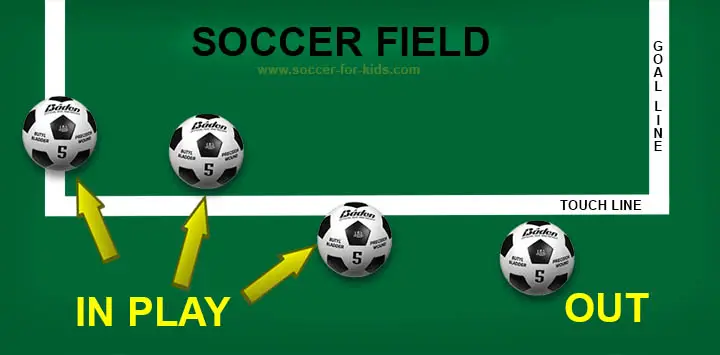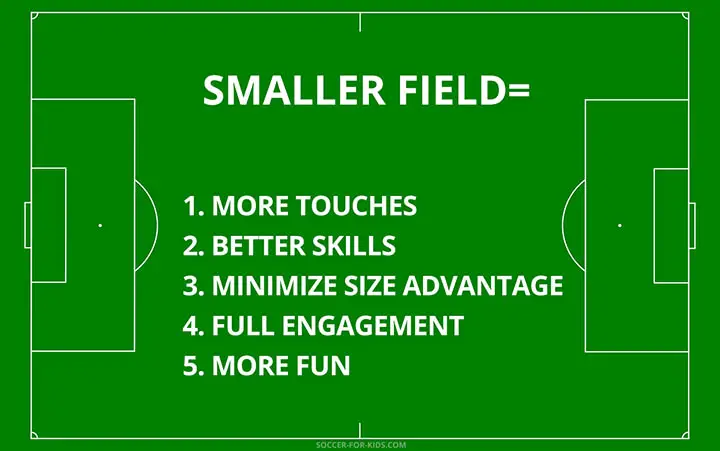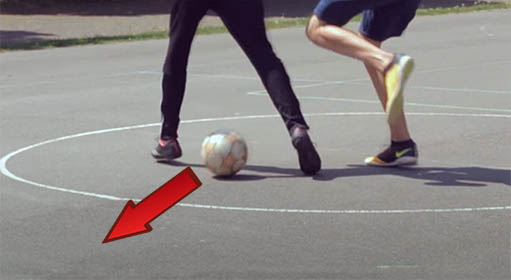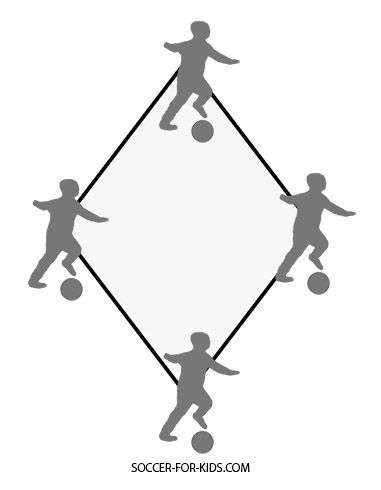10 youth soccer rules parents should know about
Not knowing the basic rule in youth soccer can lead to misunderstandings and confused or inappropriate comments from parents. I've seen it too many times. An overzealous parent starts screaming at the referee for a correct call that's enforcing a rule of the game that the parent didn't understand.
This post will give you a list of ten youth soccer rules that parents may not be aware of or don't fully understand. That's not surprising. It can be confusing, even to experienced coaches and parents. Subtle changes in soccer rules are often made and referees may even "adjust" the rules to fit the age and competition level of the players in the game.
Here is a chart of ten rules parents should be familiar with to enhance their understanding and enjoyment of the world's number one youth sport, soccer.
table of YOUTH SOCCER RULES
to help PARENTS UNDERSTAND
| RULE | EXPLANATION |
| STARTING KICK-OFF | Ball can be kicked in any direction, but only once by the first player until after another player has touched it next. |
| OFFSIDES | Offensive player must be behind two defenders or the ball when it is kicked. |
| OUT OF PLAY | In soccer, the touchline is part of the field. The ball must be completely past the touchline as viewed from above, to be considered out of play. Think of the touch line as the bottom of a wall that goes straight up into the sky. |
| ALLOWING FOR ADVANTAGE | The advantage rule is used to prevent awarding a team for fouling an opponent and taking away an advantageous position from a team that has been fouled. |
| HANDBALLS | The ball cannot come into contact with a players arm or hand and as a result give their team an advantage. |
| THE TWO TOUCH RULE | A player cannot touch the ball twice in a row when putting the ball in play. |
| DIRECT VS INDIRECT KICK | On a direct kick you can score by kicking the ball directly into the goal. On an indirect kick you cannot score until the ball is touched by another player – that is the kicker and a second player. |
| DANGEROUS PLAY | Playing in a dangerous manner is any action that, while trying to play the ball, threatens injury to someone (including themselves). This includes preventing a nearby opponent from playing the ball for fear of injury. |
| RED AND YELLOW CARDS | The yellow card indicates a caution and the red card means the immediate sending-off of a player. |
| PENALTY KICKS | If the ball does not make it into the goal and rebounds back onto the field of play, the soccer ball is "live" and anyone (except the original kicker) can play the ball. |
As an Amazon associate, soccer-for-kids receives a small commission for qualifying purchases. There is no cost to you. Zero!
more detailed EXPLANATION of soccer rules for kids
1. the opening kickoff
The first soccer rule parents should know about is how the game is started at the beginning of each half or after a goal has been scored. It used to be one of the laws of soccer that the soccer ball had to travel forward in the center circle at the start of play.
The new rule states that the ball can travel in any direction as long as it moves. Why? I've seen a few explanations of this rule for youths soccer, but the main goal of the rule change is to be able to skip the usual step of one player kicking it forward in the circle and a 2nd player kicking backward to a waiting teammate.
2. offsides
- Only the team with possession of the ball can be offside.
- Offside can only occur on the attacking half of the field.
A player is offsides when she is an attacking player and nearer to the opponent's goal line than both the ball, and the second to last opponent.
Here is a less than two minute video that will show you this rule on a soccer field.
You cannot be offside on a corner kick, goal kick, or throw-in. Also, it is not an offense for a player to be in an offside position. The player must be involved in active play as determined by the referee to be called offside.
3. when the soccer ball is out of play
The rule pertaining to when a soccer ball is fully out of play can become clearer in your mind if you think of the out of bounds line (the touchline) as an imaginary wall that extends from the painted line on the grass straight upward into the sky. The ball must full pass through that wall to be considered out of the field of play.
Note: this is different than a basketball court, where if the ball or a players foot touches any part of the line or the floor past the line is considered out of play and the other team is awarded possession of the ball.
If you were standing on the soccer field very close to the edge of the field, looking down, with the touch line right in front of you, these are the correct calls on whether the ball is in play or off the field and out of play.
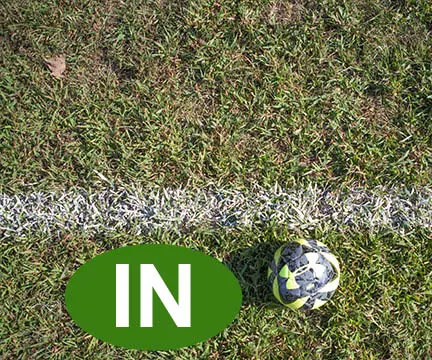 Easily recognized as in
Easily recognized as in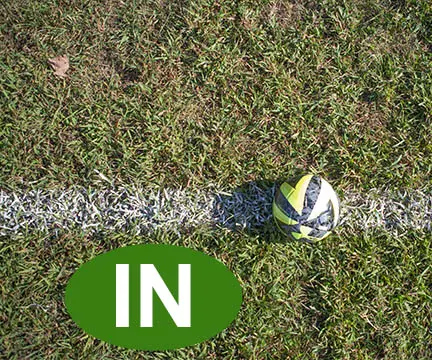 Some parents not sure
Some parents not sure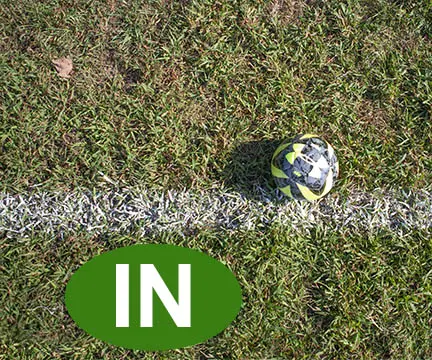 Easily misunderstood
Easily misunderstood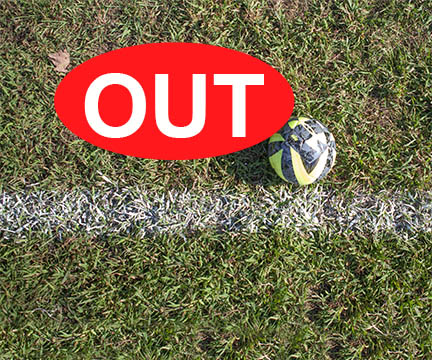 Easily recognized as out
Easily recognized as outCertainly the referees positioned at the sideline have a very good view, but not a perfect view of the ball and touchline. It's understandable, that on the close calls, the referees or volunteer linesmen for youth soccer games won't be 100% accurate in calling the ball in or out of play.
Unless you are positioned directly above the painted stripe looking down-like the NFL instant replay cameras do- you really can't be certain that the referee missed a really close call.
4. allowing for advantage
This is one of the more subjective interpretation rules that can cause some confusion with soccer parents that are new to the game. There are instances when a foul is committed, but the referees allow the play to continue because stopping the game would take away the advantage of the team that possesses the ball.
This can be upsetting to the parent of a child who has been fouled, but for the flow of the game and the benefit of the team that was fouled, play is allowed to continue.
5. handballs
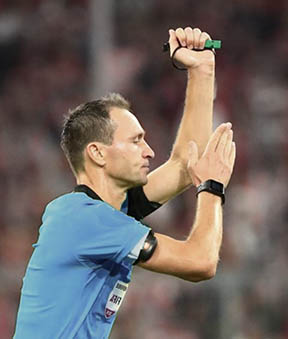 Handball Rule Signal
Handball Rule SignalThis youth soccer rule always been an odd one for me to understand. The referees have plenty of room for interpretation and often can't even see some of the handballs because their view is obstructed by other plays in her line of vision.
You'll likely hear parents yell "handball" from the sideline more than any other word or phrase. It's not just a simple matter of the soccer ball hitting a players hand or arm. Where and how fast the ball came from, whether any advantage was gained by the player, as well as the perceived intention of the player, all come into play for the referee to decide if a handball infraction should be called.
6. Two-touch Rule
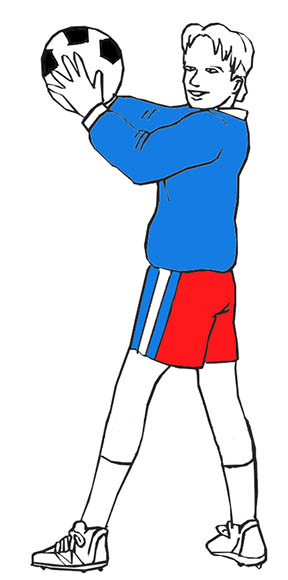
A soccer player cannot touch the ball twice in a row when putting the ball back into play. You'll see this happen a lot in youth soccer. It can occur on of both direct and indirect kicks.
Young soccer players sometimes barely strike the ball and thus are the closest ones to be able to kick the ball again. That's touch consecutive touches by the same player and it is against the rules.
This also applies to throw-ins. A player cannot throw the ball in, run to the soccer ball and then kick it until another player, on either team, touches the ball next.
7. direct vs indirect kicks
A direct kick means that it can be kicked directly at the goal and will count as a goal even if no one else touches it first. An indirect kick must touch another player before it counts as a goal.
Referees signal a direct kicks by pointing their arm directionally toward the goal and signal indirect kicks by pointing their arm upward.
8. dangerous play
One of the most common examples of a young soccer player committing a dangerous play is trying to play the ball while he or she is on the ground. Another example is when a player impedes the progress of an opponent when getting in their way intentionally when the ball is not within playing distance of either player.
Side note: A scissors or bicycle kick is permissible provided that it is not dangerous to an opponent.
9. red cards and yellow cards
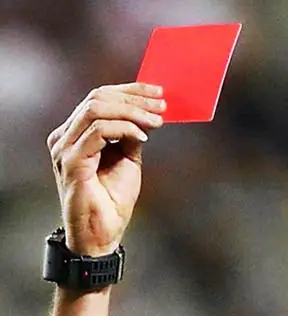 You're outta here!
You're outta here!Yellow cards are given as a caution and the list of offences that result in giving a yellow card is extensive and long enough for a lengthy article on that topic alone. Usually, what concerns parents more is what does it mean when their child receives a red or yellow card.
A red card, no matter why it was issued, means the offending player is removed from the game and cannot return to play in the game. If a player receives a 2nd yellow card in the same game he gets an automatic red card. If you are sent off as a player on the field, you cannot be replaced by another player. Your team must play shorthanded.
10. penalty kicks
Penalty kicks are perhaps the most intense play in a youth soccer match. Parents on opposing sides are cheering for a different outcome. There are two rules regarding penalty kicks parents should know about..
- All the players on both teams, except the kicker and the defending goalkeeper, must stay outside the penalty area and the penalty arc until the ball is kicked.
- The goalkeeper must have both feet on the goal line until the ball is kicked.
- After the kick, if the ball bounces onto the field, it's live and anyone can kick it-EXCEPT THE ORIGINALS KICKER.
For a complete glossary for newbie soccer parents and coaches, check out my helpful post on all the soccer terms to know.
final comments on youth soccer rules
Youth soccer parents should know the rules so that there are no ill feelings toward the referee, the opposing parents, or the children who are playing. Better understanding of the rules and how they're interpreted by youth soccer refs leads to a better experience for all concerned.
Parents would benefit tremendously by looking over the referee's rules on soccer at usyouthsoccer.org and also get some great advice on what it takes to be a good soccer parent. You don't want to behave like one of those obnoxious soccer moms.
Keep it fun. Keep it positive.


Soccer coach Bruce Lovelace started playing soccer in 1974 when, as a young boy, he constructed his own makeshift soccer goal. He played in high school, then in college and beyond. He started to coach his own children in the 1990s and then ran a Soccer Shots franchise for 12 years. Now, Coach Bruce publishes the soccer-for-kids.com website. Find out more about youth soccer coach Bruce Lovelace and what inspires this website.
Soccer-for-kids.com is a participant in the Amazon Services LLC Associates Program, an affiliate advertising program designed to provide a means for sites to earn advertising fees by advertising and linking to Amazon.com
